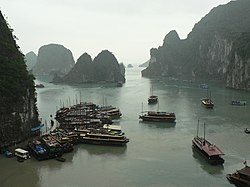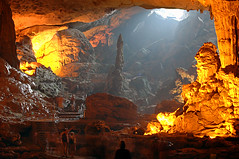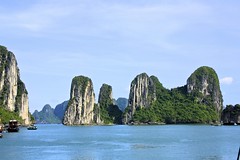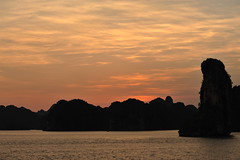Ha Long Bay (literally: "Descending Dragon Bay"; Vietnamese: Vinh Ha Long) is a UNESCO World Heritage Site, and a popular travel destination, located in Quang Ninh province, Vietnam. Administratively, the bay belongs to Ha Long City, Cam Pha town, and part of Van Don district. The bay features thousands of limestone karsts and isles in various sizes and shapes. Ha Long Bay is a center of a larger zone which includes Bai Tu Long bay to the northeast, and Cat Ba islands to the southwest. These larger zones share similar geological, geographical, geomorphological, climate, and cultural characters.
Ha Long Bay has an area of around 1,553 km2, including 1,960 islets, most of which are limestone. The core of the bay has an area of 334 km2 with a high density of 775 islets. The limestone in this bay has gone through 500 million years of formation in different conditions and environments. The evolution of the karst in this bay has taken 20 million years under the impact of the tropical wet climate. The geo-diversity of the environment in the area has created biodiversity, including a tropical evergreen biosystem, oceanic and sea shore biosystem. Ha Long Bay is home to 14 endemic floral species and 60 endemic faunal species.
The bay consists of a dense cluster of over 3,000 limestone monolithic islands (although locals claim there are only 1,969 as this is the year of Ho Chi Minh's death), each topped with thick jungle vegetation, rising spectacularly from the ocean. Several of the islands are hollow, with enormous caves. Hang Dau Go (Wooden stakes cave) is the largest grotto in the Ha Long area. French tourists visited in the late 19th century, and named the cave Grotte des Merveilles. Its three large chambers contain large numerous stalactites and stalagmites (as well as 19th century French graffiti). There are two bigger islands, Tuan Chau and Cat Ba, that have permanent inhabitants. Both of them have tourist facilities including hotels and beaches. There are a number of beautiful beaches on the smaller islands.
Some of the islands support floating villages of fishermen, who ply the shallow waters for 200 species of fish and 450 different kinds of mollusks. Many of the islands have acquired their names as a result of interpretation of their unusual shapes. Such names include Voi Islet (elephant), Ga Choi Islet (fighting cock), and Mai Nha Islet (roof). 989 of the islands have been given names. Birds and animals including bantams, antelopes, monkeys, and lizards also live on some of the islands.
 Almost all these islands are as individual towers in a classic fenglin landscape with heights from 50m to 100m, and height/width ratios of up to about six. Another specific feature of Halong Bay is the abundance of lakes inside the limestone islands. For example, Dau Be island has six enclosed lakes. All these island lakes occupy drowned dolines within fengcong karst.
Almost all these islands are as individual towers in a classic fenglin landscape with heights from 50m to 100m, and height/width ratios of up to about six. Another specific feature of Halong Bay is the abundance of lakes inside the limestone islands. For example, Dau Be island has six enclosed lakes. All these island lakes occupy drowned dolines within fengcong karst.A community of around 1,600 people live on Ha Long Bay in four fishing villages: Cua Van, Ba Hang, Cong Tau and Vong Vieng in Hung Thang commune, Ha Long city. They live on floating houses and are sustained through fishing and marine aquaculture (cultivating marine biota).
In 1962, the Vietnam Ministry of Culture, Sport and Tourism designated Ha Long Bay a 'Renowned National Landscape Monument'.
 |
| Trong Cave |
Ha Long Bay was first listed as a UNESCO World Heritage Site in 1994, in recognition of its outstanding, universal aesthetic value. In 2000 the World Heritage Committee additionally recognised Ha Long Bay for its outstanding geological and geomorphological value, and its World Heritage Listing was updated.
In 2009, the New 7 Wonders Foundation, which runs the New Seven Wonders of the World program, included Halong Bay on its list of nominations as one the World's 7 Natural Wonders.
Due to a simultaneous combination of ideal factors such as thick, pale, grey, and strong limestone layers, which are formed by fine-grained materials; hot and moist climate and slow tectonic process as a whole; Ha Long Bay has had a complete karst evolution for 20 million years. There are many types of karst topography in the bay, such as karst field.
Some of the most remarkable geological events in Ha Long Bay’s history in the last 1,000 years, include the advance of the sea, the raising of the bay area, strong erosion that has formed coral, and, pure blue and heavily salted water. This process of erosion by seawater has deeply engraved the stone, contributing to its fantastic beauty. Present-day Ha Long Bay is the result of this long process of geological evolution that has been influenced by so many factors.
Halong Bay is host to two ecosystems: a tropical, moist, evergreen rainforest ecosystem; and a marine and coastal ecosystem. The bay is home to seven endemic species.
 |
| The Kissing Rocks |
Source, Images: http://en.wikipedia.org/wiki/Halong_Bay
Some images: http://www.flickr.com/photos/



.jpg/200px-FishingVillage_HaLongBay_Vietnam_(pixinn.net).jpg)














